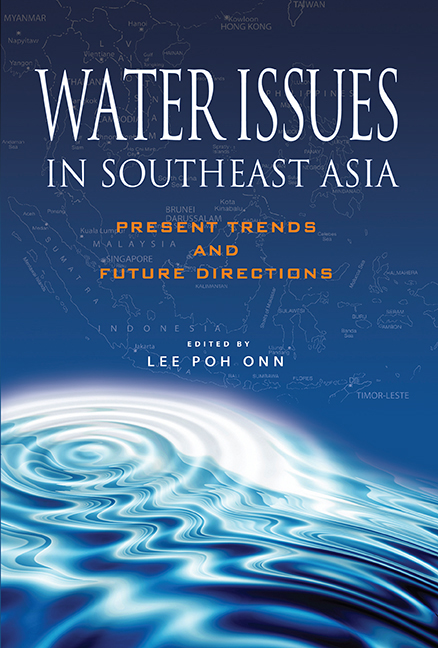Book contents
- Frontmatter
- Contents
- List of Tables, Figures, Boxes and Photos
- Acknowledgements
- About the Contributors
- CHAPTER 1 Introduction
- CHAPTER 2 China and the Potential for Conflict over Water among Eurasian States
- CHAPTER 3 River Basin Agreements as Facilitators of Development
- CHAPTER 4 Privatization of Water Services via Public-Private Partnership and Implications for Southeast Asia
- CHAPTER 5 Indonesia's Water Management Reform
- CHAPTER 6 Water Resource Management Issues in Malaysia
- CHAPTER 7 Privatization Issues in Water Supply in Malaysia
- CHAPTER 8 Troubled Waters: Rehabilitating the Pasig River, the Philippines
- CHAPTER 9 The Privatization of Water Services in Metro Manila: Lessons from a Mixed Outcome
- CHAPTER 10 Singapore's Experience in Water Resource Management
- CHAPTER 11 Thailand's Water Sector: Overview and Implications
- CHAPTER 12 Water Resources and Issues Concerning Sustainable Watershed Management Practices in Vietnam
- Index
CHAPTER 1 - Introduction
Published online by Cambridge University Press: 21 October 2015
- Frontmatter
- Contents
- List of Tables, Figures, Boxes and Photos
- Acknowledgements
- About the Contributors
- CHAPTER 1 Introduction
- CHAPTER 2 China and the Potential for Conflict over Water among Eurasian States
- CHAPTER 3 River Basin Agreements as Facilitators of Development
- CHAPTER 4 Privatization of Water Services via Public-Private Partnership and Implications for Southeast Asia
- CHAPTER 5 Indonesia's Water Management Reform
- CHAPTER 6 Water Resource Management Issues in Malaysia
- CHAPTER 7 Privatization Issues in Water Supply in Malaysia
- CHAPTER 8 Troubled Waters: Rehabilitating the Pasig River, the Philippines
- CHAPTER 9 The Privatization of Water Services in Metro Manila: Lessons from a Mixed Outcome
- CHAPTER 10 Singapore's Experience in Water Resource Management
- CHAPTER 11 Thailand's Water Sector: Overview and Implications
- CHAPTER 12 Water Resources and Issues Concerning Sustainable Watershed Management Practices in Vietnam
- Index
Summary
The availability of freshwater resources will be one of the most pressing environmental challenges in the years ahead. International dialogues in water have gone through several stages. From 1970 to the early 1980s (first stage), human health issues were the catalyst which ignited the international discussion of water. Then it was the Mar del Plata Action Plan in 1979 which called countries to develop national plans and programmes regarding the provision of water supplies and sanitation at a community level.
From the 1980s to the early 1990s (second stage), there was a growing recognition of water as an element of sustainable development. The Dublin Principles in 1992 referred to the economic value of water, and the importance of “integrated water resource management”.
From 1992 onwards (third stage), water issues have jumped in importance to become a priority issue. Water was recognized to be in a short supply; and in the Millennium Development Goals, the goal was set to include reducing or halving the proportion of population without sustainable access to safe drinking water by 2015. The Johannesburg Plan of Implementation in 2002 also reaffirmed the water supply goals of the Millennium Development Goals and also set a sanitation goal. In 2003, the United Nationals World Water Development Report also recognized that there was a water crisis globally, identified the causes, and provided tools to assess progress towards building a better future. In 2006, the United Nations World Water Development Report 2 recognized water as a shared responsibility recognizing the diverse functions of water as a resource, and also the stewardship roles that could be played by governments, communities, and individuals.
Narrowing the focus, Southeast Asia's annual per capita freshwater resources increased at an average rate of 38 per cent from 1996 to 1999 but has started to decreased at an average rate of 17 per cent beginning from 2000 to 2004, partly as a result of increases in the region's population and also development activities.
- Type
- Chapter
- Information
- Water Issues in Southeast AsiaPresent Trends and Future Direction, pp. 1 - 26Publisher: ISEAS–Yusof Ishak InstitutePrint publication year: 2012



